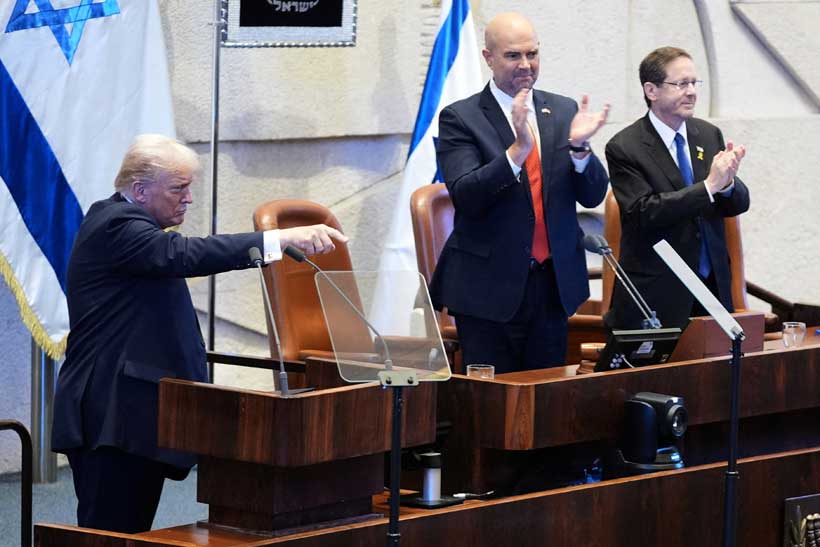On October 12, 2025, President Donald Trump began his visit to the Middle East. This marks his second trip to the region, following his first visit in May, which took place shortly before he ordered airstrikes on Iran’s nuclear facilities. This time, Trump’s itinerary includes Israel—a long-standing ally of Washington in the Middle East—and Egypt, another influential partner in the African region.
Firstly, President Donald Trump’s visit to Israel carries particularly significant meaning. The visit takes place after Trump successfully “brokered” a 20-point agreement between Israel and Hamas. Under this deal, Hamas agreed to release Israeli hostages, while Israel would free thousands of Palestinian prisoners. In this context, the visit can be seen as an “inspection trip” by the U.S. President to assess both sides’ implementation of the agreement.
Secondly, the visit also demonstrates that Trump is a hands-on leader. Within just four hours, he carried out a series of diplomatic activities in Tel Aviv, including visiting and delivering a speech at the Knesset (Israel’s parliament) and meeting with Israeli hostages who had been abducted during the October 7, 2023, attacks. These engagements reinforced the image of a United States that closely monitors global developments and dynamics. Strengthening this image enables America to secure key agreements, as it sends a clear message to nations that oppose Washington—particularly China, a country that has openly challenged the U.S. in its bid to become the new global leader. Therefore, despite lasting only four hours, the visit underscored the significant influence of the United States on regional and global affairs.
Thirdly, Trump’s brief four-hour visit to Israel also carries an implicit message about the potential for cooperation with the United States—not only for its allies and partners but even for rival nations. The visit highlights the enduring strength of U.S.–Israel relations and sends a broader signal to other countries around the world about the value of building mutually beneficial partnerships with Washington. Cooperation with the United States can bring support and even security guarantees—as exemplified by Israel.
During his first term, Trump was often seen as an “outsider” lacking experience in international politics, which led some allies and partners to doubt or distance themselves from U.S. influence. Therefore, this visit serves to reinforce America’s image and restore confidence among its partners and allies.
President Donald Trump’s order to bomb Iran’s nuclear facilities sparked widespread controversy. At the time, Trump declared that Iran’s nuclear sites had been destroyed. However, the CIA later stated that the strikes only hit the outer perimeter and caused no significant damage. Typically, consistency in messaging reflects the professionalism of the U.S. administration, making this rare instance of conflicting statements noteworthy.
In this case, the release of two differing narratives can be interpreted as a calculated move by the Trump administration to open a channel for potential cooperation with Iran. As the primary sponsor of Hamas, Tehran may have perceived the message that it could achieve economic gains—after decades of sanctions—if it pressured Hamas to return to the negotiating table.
Before the 1979 Islamic Revolution, Iran was one of America’s key outposts under Shah Pahlavi and, with U.S. support, became one of the fastest-growing economies in the world at the time. For Trump, cooperation with Iran could potentially dismantle the “Iran–China–Russia axis.” Therefore, a future resumption of U.S.–Iran cooperation remains entirely possible, with the first step likely being the restoration of the JCPOA. Top of Form
Bottom of Form
Fourthly, Trump’s visit to Israel leaves open the possibility that the United States under his leadership may expand the Free and Open Indo-Pacific (FOIP) Strategy. Since the “Pivot to Asia” launched under President Barack Obama, Washington has sought to reduce its military and political footprint in the Middle East and redirect attention toward the Asia-Pacific to counter China.
During Trump’s first term, the U.S. broadened the scope of FOIP in 2017 while still maintaining interest in Israel and the Middle East. Under President Joe Biden, the establishment of the I2U2 grouping—which includes Israel—signaled Washington’s intent to position Tel Aviv as a new pillar within its foreign policy strategy. This move also aimed to deepen the involvement of U.S. partners and allies in the Indo-Pacific within the Middle Eastern context.
The evolving approaches of the last three U.S. presidents toward the Middle East reflect a broader policy trend in which American strategists seek to reshape U.S. foreign policy toward the region—effectively integrating the Middle East into the FOIP framework. The ultimate goal is to build a continuous strategic arc stretching from the U.S. West Coast to Israel, thereby countering China’s growing presence through the Belt and Road Initiative.
Although Donald Trump’s visit to Israel lasted only four hours, it encapsulated the strategic importance of Tel Aviv—and the broader Middle East—in U.S. policy planning under his administration and likely those that follow. The visit underscored Washington’s intention to strengthen its network of partners and allies while reaffirming America’s global standing, with an eye toward confronting China in the future—in whatever form that confrontation may take.

